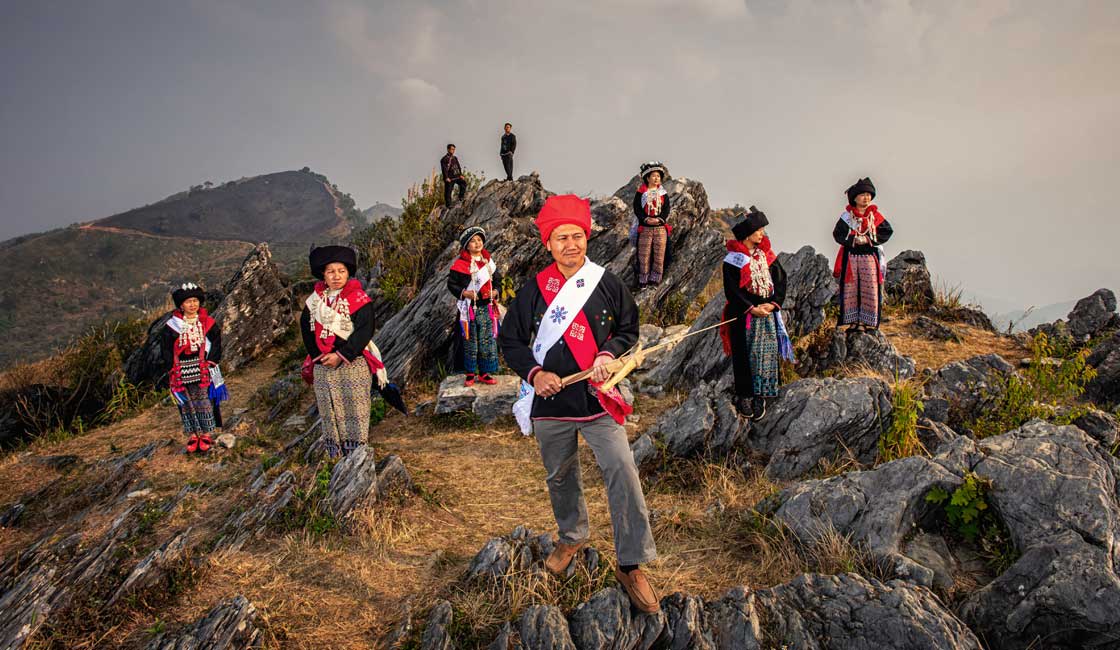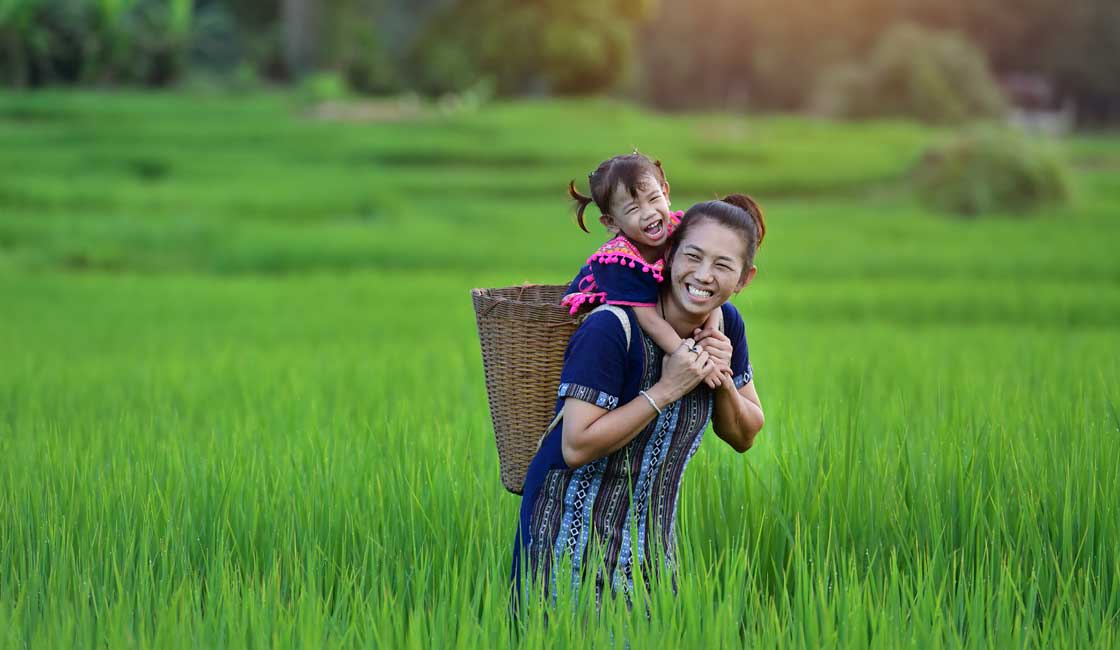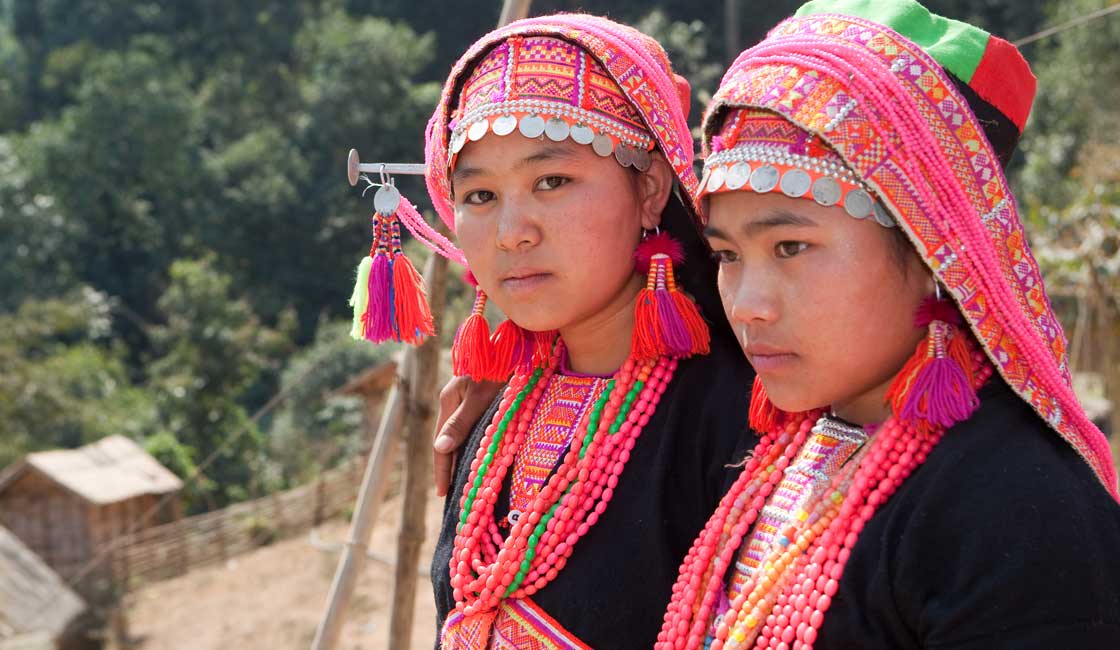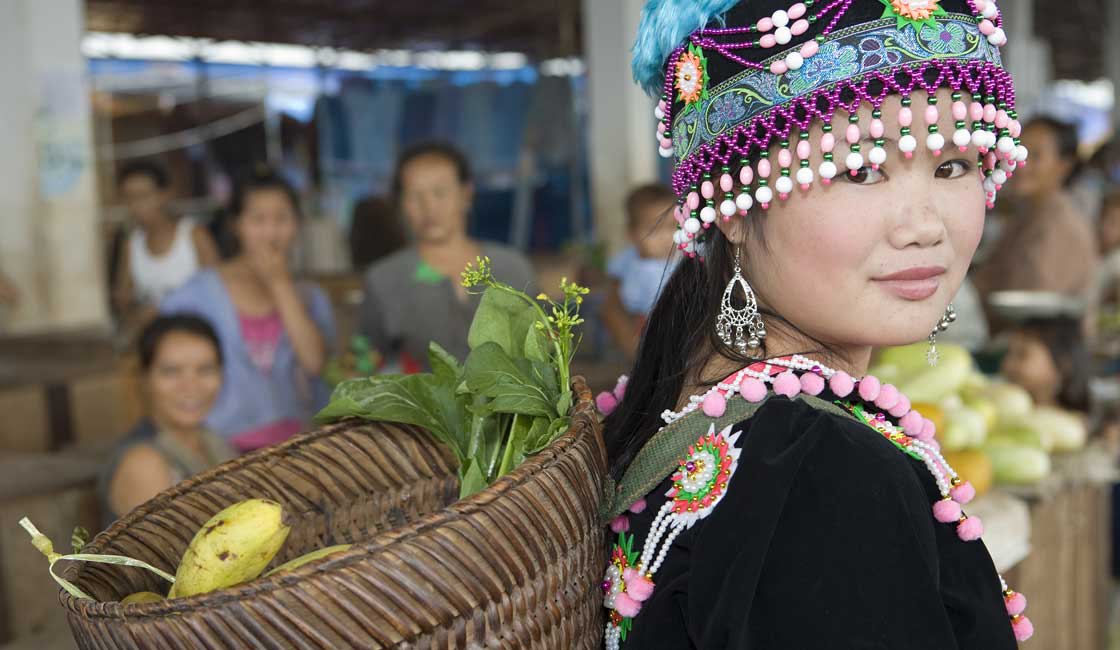
Southeast Asia is a remarkable corner of the world. A melting pot of cultures, ethnicities, and religions, not to mention the natural world. Visiting the region is fascinating because of the crisscrossing ethnic groups that are unique to the different countries. In tracing the ethnicities of the countries of Southeast Asia, you can learn so much about this part of the world’s roller-coaster history, and unlock rich traditions and beautiful cultures found nowhere else on Earth.
What better place to start than right in the middle – Laos. It’s a totally landlocked country, bound on all sides by Myanmar, China, Vietnam, Cambodia, and Thailand. No wonder, then, that the Lao PDR (Lao People’s Democratic Republic) is the most ethnically diverse country in the whole of Southeast Asia…
Despite its central location, Laos is one of the most sparsely populated countries in the region, with around 7 million people living in an area of land roughly half the size of France, or slightly larger than Utah in the United States. To put this into context, there are seven times as many people per square mile living in Thailand, while Vietnam has fourteen times as many.

In the rice fields
Like many of its neighboring countries, the ethnic make-up of Laos is a fairly complex matter. According to the Lao Front for National Construction, there are 160 ethnic groups in total, divided up into 49 ethnicities. However, experts believe that the real number of ethnic groups is much, much higher, at something like 240 different ethnic groups. There are 82 different languages spoken throughout these 160 groups. The main group is the ethnic Lao, who make up 53% of the population.
A common mistake is to call people from Laos ‘Lao’. The correct term for people that live in Laos is ‘Laotian’. The term ‘indigenous peoples’ is not used by the Laotian government. Instead, they refer to non-Lao people as ‘ethnic minorities’.
Historically, the population was divided up into three groups – the Lao Loum (lowland dwellers – these were in the majority), the Lao Theung (people who live in the mid-altitude levels), and the Lao Soung (who inhabit the uplands). The three groups corresponded to their different means of agriculture too. Lao Loum were rice farmers, living around the fertile Mekong river delta. Lao Theung and Lao Soung on the other hand practiced shifting cultivation. As well as these three groups, there was a large portion of people who lived in Lao with other Asian heritage.
Because these categories were based on geographical and agricultural rather than ethnic differences, they were done away with by the Lao government in 1981. Although new ways of categorizing the ethnic groups of Laos have been invented, Laotians often still refer to themselves using these ethnic groups.

Villages still upholding the charms of the traditions
Today, the official system contains four different ethnolinguistic groups. These are Lao-Tai (the original Lao Loum), Mon-Khmer (mainly Lao Theung), Hmong-Mien (Lao Soung), and Chinese-Tibetan.
The Lao-Tai are the dominant ethnicity, mostly made up of Lao people, and they tend to live in the lowlands where the wetlands lend themselves to rice farming. They arrived in what is now called Laos in the first millennium, from the south of China. Today, they are the vast majority and control most of the Laotian government.
The Mon-Khmer are the indigenous people that moved into the area around 3000 years ago, from India. Originally they were wet-rice farmers but were displaced and forced up the sides of the mountains by the migration of the Lao-Tai. They have the widest range of linguistic and cultural differences and have many different subgroups.
The Hmong-Mien and the Chinese-Tibetan arrived fairly recently in the 19th century from China and today these two ethnolinguistic groups live on the mountains in the northern provinces of Laos. Together they make up a group of peoples composed of several ethnic groups (Hmong, Mien/ Yao, Akha etc). They mostly migrated down to Laos, forced to flee the many violent revolts happening in Southern China between 1850 and 1870.
Today, the Laos ethnic groups map still very much reflects the physical landscape of the country. The geographical divide between highlanders and lowlanders has had a big impact on the cultural make-up of Laos. In fact, these physical divisions of numerous mountain ranges, plains, plateaus, and rivers have been credited as one of the reasons Laos is so ethnically diverse, keeping tribes fairly separate, and preserving many of their traditional practices.
Historically, there has long been tension between the Lao-Tai (Lao Loum, the people who live in the lowlands) and the other groups – this dates back thousands of years. It was the Lao Loum that displaced the Lao Theung (Mon Khmer) from the lowlands in the first place, and this evolved into an exploitative relationship where the new lowlanders (Lao Loum) were the dominant force, and the Lao Theung were referred to pejoratively as ‘Kha’, meaning ‘slave’. This ended up being exacerbated during the period of French colonial rule. Even today, non-Lao ethnic groups are underrepresented in government.
You can’t fail to be charmed by the rich culture, traditions, cuisine, and dress of Laos’s ethnic groups. For those of us used to a high-energy modern living, it’s hard to imagine what life must be like for those groups of people living in hill tribes in the mountains of Laos, or imagine how life must differ from those ethnic Lao living in the country’s main urban areas.
With up to 240 different ethnic groups in Laos, it can get pretty confusing pretty quickly. Rather than get too stuck into the ethnological ingredients of the country, let’s have a closer look at a few ethnic groups in particular. How and where do different ethnic groups and tribes live in Laos?

As you travel through Laos villages appear among hills
Ethnic Lao people make up the biggest group in Laos, comprising 53.2 percent of the population. They occupy the low-lying wetlands around the vast Mekong river delta, at elevations of under 1000 meters. The natural resources here are ideal for rice agriculture, which is the main farming practice by the ethnic Lao. Physically, they resemble Thai people, and they share much ancestry with people living in Thailand. In fact, a huge proportion of ethnic Lao people live in Thailand now.
Although there are tens and tens of different languages spoken in Laos, the Lao language is the official language of Laos. It’s used in government, education, and all official situations. There are about five different dialects within this language, but they’re all similar enough to be understood amongst the speakers.
Religiously speaking, the Lao people predominantly practice Theravada Buddhism. However, they incorporate certain Hindu and animist traditions into their religious practices. Among those worshiped are guardian spirits, malevolent spirits, ancestral spirits, and the gods of heaven, earth, fire, and water. The Buddhist temple is the heart of all life for the Lao people and the Buddhist monks are treated with deep respect throughout the country. Lao people tend to bow and kneel before passing monks – a reverence that you can experience for yourself if you witness the Luang Prabang morning alms giving ceremony.

Khmu village
The Khmu is a large ethnic group that is part of the Mon-Khmer ethnolinguistic group. They make up roughly 11 percent of the population of Laos, but small populations of Khmu can also be found in parts of southwest China, Vietnam, Myanmar, and Thailand. On the whole, the Laotian Khmu live in villages mostly in the northern provinces of Laos. These villages are fairly isolated, and only a few have access to electricity.
They are indigenous to the area but were pushed up to higher altitudes with the arrival of Tai peoples, where they now practice swidden farming (slash and burn agriculture). Farming among the Khmu is a communal affair, and the harvesting of rice from the swidden fields is mostly done by women. Crops normally include sticky rice, bananas, beans, sesame, and other vegetables.
The Khmu are enshrouded in mythology and folklore, with ancient stories involving ghosts, devils, spirits, and a deep connection with the sun and the moon. Storytelling is a big part of their culture today, and they tell tales of their culture and history through evening recitals around village fires.
House-building is an important and reverential process for Khmu people. Each Khmu family is, according to legend, protected by a specific animal totem (for example an eagle or a bear), and their houses are holy places. The house must be built in line with the path of the sun, with a door facing east so that inhabitants can be greeted in the morning by the rising sun. For Khmu people, the sun is pure and cleansing. Needless to say, nowadays these beliefs are less adhered to, but the sun is still considered a significant force in village life.

Traditional outfits of Akha
In the western highlands of Laos, you can find the Akha. The Akha are part of the Chino-Tibetan subset (or Tibeto-Burman language family) of the Laotian population, and they make up around 1.8 percent of the population. They are famous for their iconic traditional costumes and profound connection with the forest in which they live and farm. It’s unknown exactly where their original homeland was, but it’s thought to be either the Tibetan borderlands of China’s Yunnan province.
The Akha are skilled hunters, and they farm crops as well as fish and forage for a living. They have deep knowledge and understanding of nature, and many of their religious beliefs are based on animism and spirituality that connect them to the natural world. Their houses are either built low to the ground or high on stilts and some villages are nomadic, every now and then dismantling, moving on, and setting up elsewhere.
Clothing in Akha hill tribes is renowned for its extravagance and beauty. The women, in particular, wear beautiful skirts over leggings, and bodices decked out in intricate embroidery and appliqué. Textiles are a big part of the lives of women in these villages, spinning cotton, weaving it into cloth which is then dyed indigo and heavily embroidered. Their headdresses differ in size and ornamentation depending on how old the woman is, or whether they are married. Some of the most elaborate are huge and covered in silver coins, beaded sashes, fur, and feathers.
These traditional outfits are brought out mainly on ceremonial occasions, such as the Akha Swing Festival that happens in late August. This has become known as the Women’s New Year because it’s a chance for them to dress up in their best ornate clothing that they’ve spent the year making and decorating. The festival happens on the 120th day after the planting of the village rice and involves ritual offerings, traditional dances and songs, and of course food. For a beautiful insight into the lives of the Akha, check out this collection of photographs.

Distinctive Yao style
Part of the Hmong-Mien subgroup, the Yao people are a large group made up of a number of ethnic groups. The main one of these is the Mien, another of which is the Lanten, both of which live in Laos. They moved out of China to Laos due to infertile lands and pressures from the Chinese government.
Their lifestyle revolves around rice farming, dying of clothes, silversmithing, and a strictly patriarchal society. The men will likely have up to seven wives, and marriage between first cousins isn’t uncommon. The villages are fairly small, and their belief system seems to be linked to ancestor worship, animism, and even Taoism. The Yao peoples have a deep and spiritual connection with their ancestors and the natural world.
As clothes dying is such a big part of their lives, you can imagine that Yao cultural dress is pretty spectacular. For the Mien, female clothing includes big turbans and headdresses, long robes belted with sashes, and red tassels and fringes stitched onto the neckline. All this (apart from the red fringe) is generally dyed black or dark blue, and jewelry and other trinkets are worn too as a display of wealth. Male Mien tends to be less ornate, wearing dark blue trousers with a loose jacket, decorated with hem and cuff embroidery and silver buttons.
Lanten tribes are also dark blue when it comes to traditional dress, with long-sleeved jackets and wide trousers for the women, with embroidered fronts and large silver necklaces. The women of Lanten villages also have shaved eyebrows and far-back hairlines. The men of these tribes wear a fairly similar outfit – long trousers and dark blue tops.

Stilted houses of Katang people
Another of the original indigenous people of Laos is the Katang (also spelled Kataang) who formerly fell into the Lao Theung (Mon-Khmer) category. Unlike most other Lao Theung, they do not live up high in trees or on stilts. Instead, the Katang build communal longhouses out of wood, and these houses are extended each time a Katan man marries a woman – adding another room for his new family. The houses can get crazily long, one reaching up to 328 feet long.
Katang people practice a variety of religions, mostly based on old ancestral beliefs mixed with Buddhism. Traditionally, Katang men and women have wide ear piercings, using a tube of bamboo to stretch the lobes – however, this is barely practiced anymore.

Hmong headpieces are particularly beautiful
The Hmong are an ethnic group that has faced a history fraught with conflict, persecution, and betrayal. In the last century alone, they were recruited as part of the ‘Secret War’ by France and the United States to fight against the communist Pathet Lao army and forces from North and South Vietnam. After the 1975 communist victory, thousands of Hmong political refugees were rendered homeless, fleeing Laos and mostly ending up in America, France, and a few other countries around the world. Today, there is still tension between the government of Laos and the Hmong population.
The Hmong that still lives in Laos number at roughly 9 percent of the country, mostly keeping themselves apart from other tribes on the mountain tops. They are renowned for their skills with natural and herbal medicines, carpentry, blacksmithing, weaving, and embroidery. They wear stunning hemp clothing adorned by intricate embroidery and silver jewelry. Like other hill tribes, spirits and the supernatural feature heavily in their beliefs, and they believe in a twin spirit for each Hmong person, that guides them through their lives. Funerals for the Hmong are very long, lasting several days. This is because they believe that the spirits of the dead must find their way back to their birthplace, then travel on to meet their ancestors in the afterlife – the long funerals help guide them and ensure safe passage.

Akha village
Hill tribe trekking in Southeast Asia has become a popular adventure for travelers from all over the world and there’s no doubt that there’s a lot to learn from indigenous and ethnic groups. Popular destinations to encounter and get an insight into ethnic villages include the stunningly mountainous Sapa in northern Vietnam or the beautiful and ancient Chiang Mai in Thailand. The hill tribes of Laos, on the other hand, are much less visited – an exquisite window into the country’s cultural past. Areas in Laos such as Bokeo, Luang Namtha, and Phongsali have amazing diversity and remain off the radar when it comes to general tourism.
Of course, it should go without saying that these places should not be taken for granted or interfered with – their very beauty lies in their preservation. If you do choose to visit a hill tribe in Laos, you have a responsibility to respect their customs, to keep a low profile, and to be sensitive to the fact that your ways of life will differ enormously. Here are a few tips for ensuring a respectful and enjoyable visit:
Visiting a hill tribe in Laos is one of the most exciting and memorable things to do in Southeast Asia – and should be considered a privilege. Many of these ethnic groups have deep bonds with nature and the world around them, and that has fed into their ways of life. There is so much that we can learn from observing these special, minority cultures.
While Rainforest Cruises aim to provide accurate and up-to-date information, we make no representations as to the accuracy or completeness of any information herein or found by following any link on this site. Rainforest Cruises cannot and will not accept responsibility for any omissions or inaccuracies, or for any consequences arising therefrom, including any losses, injuries, or damages resulting from the display or use of this information.




